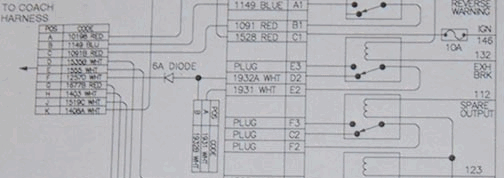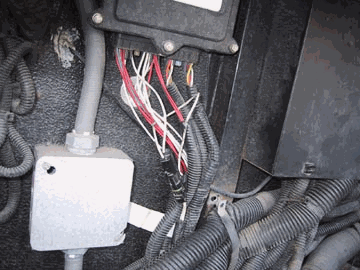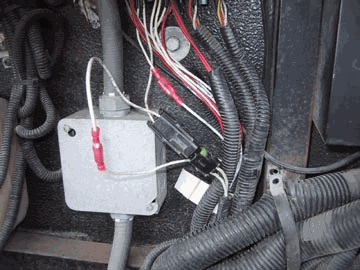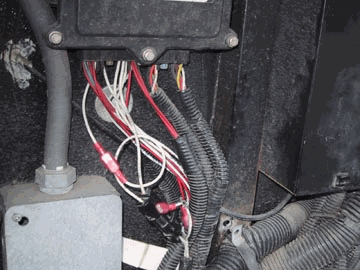

My 1998 Discovery, and all Ds up to possibly the 2003 models, is wired such that when the exhaust brake engages the brake lights come on, and therefore the cruise control is disabled. When I am through slowing down, I have to manually turn the cruise control back on. The cruise control is disabled by the same signal that occurs when the brake pedal is stepped on; that is, by the 12-volt power applied to the stop light relay. So how can you keep the exhaust brake from shutting down the cruise control?
Let's look at how the brake light system works. The brake lights are not turned on directly by the wiring from the "stop lamp switches" that are connected to the brake pedal. These switches power a wire that closes a relay that powers the brake lights. On my 98 D, the 1257 series wires carry power from the stop lamp switches to the stop light relay; the wires from the relay that carry power to the brake lights are the 1005 series.
So the sequence is: You step on the brakes. The "stop lamp" switch energizes the 1257 wires. Power in the 1257 wires closes the stop light relay, and then continues on to a cruise control circuit, where it disables the cruise control. The stop light relay powers the 1005 wires and turns on the brake lights. A branch in the 1005 series wire carries power to the turn signal and hazard light switch.
Between the stop lamp switches and the stop light relay there is a junction where the exhaust brake circuits can provide power to the 1257 wire and thereby close the stop light relay, and turn on the brake lights. Since this is after the stop lamp switch, it is necessary to keep 12V power from back feeding into the exhaust brake control circuits when the brake pedal is stepped on. This is done by a 6 amp diode in the wire coming from the exhaust brake control to the 1257 wire.
OK, here is how the exhaust brake circuits are connected to the stop light relay circuit, from the wiring diagrams supplied by Freightliner for my year coach. Look for the 6A DIODE:

This a partial copy of Figure 7, Transmission Harness Schematic, from the Freightliner Recreation Vehicle Workshop Manual, Section Wiring # 54.00 It is also shown on Sheets 1 and 3 of the Schematic, Electrical, that I got for my particular coach. (Call and ask Freightliner, they will send you yours.)
The diagram shows the wiring connected to the Allison VIM, the transmission control box located on the front center of the firewall of my 98 model. (NOTE: The location of the Allison VIM was changed sometimes after November, 1997. I do not know the new location of the Allison VIM. Please advise Ed Kennedy if you know the new location). Since the Exhaust Brake is an option, it is connected to the Transmission control system through a two-wire connector just below the VIM. (The diagram does not show the wires from the connector back to the exhaust brake controls.)
Wire 1931 on the two-wire connector carries 12-volt power from the exhaust brake circuits to the VIM. The VIM then allows it to pass through a relay to wire 1932A, and on to a junction. The 1932B wire leads from this junction back to the two wire connector, and then through it back to the exhaust brake circuits. Another wire leads from the junction to the 6amp diode, and the other side of the diode connects to the 1257 circuit that activates the brake light relay.
So to keep the exhaust brake from turning on the brake lights and disabling the cruise control, it is necessary to modify this wiring such that the VIM can pass the power from the 1931A wire on to the 1932B wire (and back through the two wire connector to the exhaust brake), but keep that 12 volt power from getting to the diode.
All that takes is to cut two wires, splice two of the four ends together and leave the other two dangling, unused.
The modification project:
Ready to begin? Find the two-wire connector near the VIM, and the two white wires coming out of the two-wire connector. Here is my 98 model:

You can see where the 1931 wire goes from the two-wire connector into the VIM. (All the wires are numbered. Not always easy to find and read, but they are. My 1931 wire was labeled on the back, right where it entered the VIM)
You can also see a white wire going from the two-wire connector back into one of the wiring bundles that goes to the VIM. This is the 1932B wire which runs from the diode junction back to the two-wire connector. (You can unwrap the wire bundle and verify that it is the 1932B wire.)
Immediately to the left (facing the VIM) of where the 1931 wire enters the VIM is a white wire, which goes from the VIM into that same wire bundle. Find the number on this wire; it should be 1932A. This is the wire that leads to the diode junction. This picture shows me holding both 1932 wires, the 1932A coming out of the VIM into the wire bundle and the 1932B coming out of the wire bundle into the two-wire connector:

The two-wire connector has been unplugged, and the end connected to the VIM is behind my hand. Now if we cut the 1932A wire coming from the VIM to the wire bundle, and on to the diode, and the 1932B wire coming from the wire bundle to the two-wire connector, and fasten them together, we will have cut the power to the diode, and to the 1257 wires. I used male & female plug-in connectors, in case I ever want to put the system back as it was. Here are the cut wires, with the connectors installed and hooked back together, but still in the original configuration:

Now I unplug the connectors and make the connections I want: the 1932A wire coming from the VIM connected to the 1932B coming from the two-wire connector. This leaves the 1932A wire leading to the diode and the 1932B wire coming from the diode just hanging loose:

Now tape the whole mess up with electrical tape to weatherproof it, and your exhaust brake will not turn on your brake lights or disable your cruise control:

That's all there is to it. For the skeptics among you, check out the wiring diagrams and see for yourselves.
How does it work, before and after the mod:
Consider the following: If you are traveling on level ground or going up hill, and are running at or below cruise speed, and you turn on the exhaust brake, what happens? Nothing. Because the cruise control is feeding fuel to the engine, and the exhaust brake will not turn on when the engine is receiving fuel.
Continuing on up the hill, you reach the crest, and start downhill. Does the exhaust brake go on? Not until the cruise control cuts off fuel to the engine because the vehicle has exceeded the cruise set speed. Now the exhaust brake cuts in, the brake lights go on, the cruise control is disabled just as if you had stepped on the brake pedal, and the vehicle slows.
What happens when the cruise set speed is passed while the vehicle is slowing?
Nothing. It just keeps on slowing. You have to press the "resume" button or step on the gas to de-activate the exhaust brake. This gets to be old hat after a while, and many of us just downshift going downhill to control speed (if the hill isn't too steep) and wait for the cruise control to come back on when we have slowed enough. Or we use the exhaust brake, and forget about the cruise control. Either way, we grumble about having to manually control the vehicle.
But with that one wire change, it will work like this:
You start downhill, and the speed builds up past the cruise set speed. The exhaust brake comes on, and the vehicle slows - BUT the brake lights don't come on, and the cruise control is still active, but it isn't feeding fuel to the engine. When you slow to the cruise set speed, the cruise control starts feeding fuel to the engine. The exhaust brake immediately shuts off, and the cruise control governs the speed. If you speed up past the cruise set speed, the cycle repeats.
This mod makes cruising with both the cruise control and the exhaust brake "on" effortless, and promotes usage of both systems.
Well, what about other cars on the road? Shouldn't you have brake lights on when the extarder is slowing your RV? How many trucks and passenger cars do you see whose brake lights come on when the driver takes his foot off the gas and uses compression braking, or lower gear braking to slow down? None. How many busses and big trucks do you see whose brake lights come on if they use compression or exhaust braking to slow down?
Try it, you'll like it.
Submitted by Ed Kennedy
98 34Q
The DISCOVERY OWNERS ASSOCIATION, INC, was formed to promote the sharing of information and the camaraderie of fellow Discovery motorhome owners. Membership in the club is limited to owners of Fleetwood Discovery motorhomes.